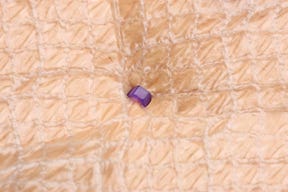Details Are King For Bioresorbable Polymers
There is a phrase Dennis Jamiolkowski is fond of using in his talks about bioresorbable polymers: “The devil is in the details...but then so are the angels.” As a distinguished research fellow at surgical suture maker Ethicon, Jamiolkowski has been at the forefront of research into synthetic bioresorbable polymers used in medical devices.
September 12, 2012
Medical devices made from bioresorbable polymers have already enjoyed a good deal of commercial success. Products like Ethicon’s Securestrap, a device used for mesh fixation in endoscopic procedures, are already providing bioresorbable technology to patients. Bioresorbable polymers are also used in implants and orthopedic devices such as sutures, stents, screws, and plates.
|
An absorbable fixation strap is embedded into a mesh fiber - image courtesy Ethicon |
The basic premise is straightforward: Devices made from bioresorbable materials can be naturally broken down and eliminated by the body, meaning once an implant is placed, there’s no need for a second surgery to remove it. A bioresorbable plate, for example, can be absorbed by the body over the time it takes for the broken bone to heal.
What’s not so simple is the chemistry. In the past, bioresorbable implants have failed, to frightening results. Bioresorbable knee pins have broken down incorrectly, releasing harmful acids into patients’ knees, for example. Jamiolkowski cautions that a comprehensive understanding of the chemistry and polymer morphology of these polymers is key in designing such devices. “I would say there are not enough people who understand the details,” he says.
Bioresorbables function essentially by chemical hydrolysis. As water (which is omnipresent in the human body) makes contact with the material, the polymer’s chemical bonds break apart, eventually leading to the complete breakdown of the material. The rate at which this hydrolysis happens depends on a variety of factors including the chemistry and structure of the material. Braided sutures, for example, tend to be made of softer material than single-strand ones. But by weaving the material into braids, which orients the chemical bonds in the same direction, the rate of hydrolysis can be controlled. Having this sort of control is important from a clinical perspective because doctors do not want a patient’s implant to break down before an injury is appropriately healed.
|
Absorbable fixation straps to fasten hernia mesh to soft tissue are used by the Ethicon Securestrap 5-mm absorbable strap fixation device. Image courtesy Ethicon |
In his own work with sutures, Jamiolkowski and his fellow researchers skillfully balance a variety of polymeric properties such as glass transition temperature (Tg), the temperature at which a material goes from a glass state to a rubbery one (or vice versa). “A monofilament suture needs a very low Tg (e.g., –10°C) so that its Young’s Modulus is low—that is, that it is soft and pliable. It will not be wiry and thus can be more easily controlled, especially in knot tying,” Jamiolkowski says. “[But] there are instances where we want to use a different chemistry. Let’s say we want to have the article absorb at a different rate. If you modify the chemistry, the Tg will change. If it gets too high—too stiff—and the goal is a new suture material, the new polymer may need to be made into a braided multifilament construction rather than a monofilament fiber.”
The absorption profile of a material is also important. Manufacturers need to look at the rate of absorption and how quickly a material will lose mechanical properties over time, particularly because different body tissues heal at different rates and factors such as age affect how fast a person’s body heals. “There are opportunities and situations where you want the article to do its job and disappear quickly and others where you want it to hold mechanical property for a fairly long time,” Jamiolkowski says.
All of this, ultimately, is done in service of patients and doctors. “The idea is to give surgeons a choice,” Jamiolkowski says. “We take into account compromised patients to see what kind of properties we’re looking for. We produce materials that have an array of properties. The surgeon is then informed about what those properties are, and it is then up to them to choose. They are the ones that understand the clinical situation, and the patient (age, medical conditions, etc.). It all comes down to being able to produce an array of materials.”
Dennis Jamiolkowski will be speaking more on bioresorbable polymers as part of the MedTech Polymers Conference
Chris Wiltz is the Assistant Editor at MD+DI
You May Also Like




